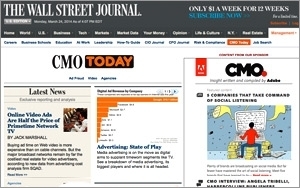'Wall Street Journal' Launches Digital CMO Today
- by Gavin O'Malley @mp_gavin, March 24, 2014
 Don’t call it native, but Adobe is committing significant resources to establish an ongoing editorial-like presence on WSJ.com.
Don’t call it native, but Adobe is committing significant resources to establish an ongoing editorial-like presence on WSJ.com.
As part of the multi-year ad
pact, The Wall Street Journal has created a new digital section, CMO Today, which caters to the same marketing professionals that Adobe hopes to call
clients. “It’s native-esque,” Trevor Fellows, head of global ad sales at The Wall Street Journal, said on Monday.
In exchange for what Fellows called a
“significant investment” by Adobe, he added: “We’re allowing our sponsor to place highly relevant content [on WSJ.com].”
“But there is absolutely no blurring of the line between editorial and advertising,” Fellows made clear. “We’re unequivocally opposed to that.”
CMO Today’s front page features two sections: editorial content from WSJ’s staff and other news publications on the left side, while on the right, Adobe’s “CMO.” includes “insight written and compiled by Adobe.” Linked directly to CMO.com -- Adobe’s owned-and-operated destination for marketing industry news -- "CMO." includes stories like “5 Companies That Take Command of Social Listening” and “5 Ways [One] Marketing VP Escaped Extinction.”
CMO Today is the newspaper's fourth content vertical since the debut of CFO Journal in mid-2011. The business news publisher later launched CIO Journal in mid-2012, and Risk & Compliance Journal in early-2013.
Native advertising, however, has only recently become a big priority for the publisher -- a push that comes amid increasing discussion over media’s willingness to cede control of editorial to advertisers.
Unlike some publishers, WSJ's editorial department will never
produce content for Adobe, said Fellows. WSJ. Custom Studios -- the publisher’s recently launched content marketing division -- might fashion some editorial-like fare for Adobe, he said. (To be
clear, however, Fellows said the Adobe deal was not a product of WSJ. Custom Studios.)
Still, for The Wall Street Journal, “there is a high degree of reputational
risk,” said Ryan Skinner, an analyst at Forrester Research. “If they screw this up, they lose audience, which creates a cascade of bad things.” For Adobe, “there is primarily
financial risk,” he added. “If they screw this up, they waste money. The success of the endeavor will [come] down to whether these investments look or feel good from the perspective of the
readers, who will vote with their clicks, shares and time,” Skinner added.
J.P. Morgan recently predicted that native formats would soon take over digital channels, while eMarketer
predicts that native ad spending will hit $2.85 billion, this year.
Yet, like many skeptics, Fellows doesn’t think native can scale. “It depends on your definition of native, but to do native right, you need sponsors that have stories to tell, and who are willing to make significant content investments,” Fellows said. “That, and the more [native partnerships] you do, the less special they become.”
Industry thought leaders have implored publishers and brands to rethink their rapid embrace of native partnerships.
“Publishers should say no, more than yes, to native,” Steve Rubel, executive vice president of global strategy and insights at Edelman, told attendees an the OMMA Native conference in November. “As an industry, we’re going way too fast.”
Taking an investigative approach to the business of marketing, CMO Today has a full-time staff of five reporters. As WSJ’s newly named advertising editor, Suzanne Vranica is running the show.
Adobe was not available to comment for this story by press time.



WSJ should be thanked, not slapped for helping to legitimize native advertising and infusing a major dose of credibility to the format. When done responsibly, as we're seeing with Airpush, Twitter, and a number of other major ad networks, social networks, and top publishers, native ads are as close as we're going to get to ads that truly benefit consumers and advertisers equally.